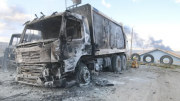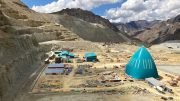As Canada’s Nunavut territory approaches its tenth anniversary on April 1, we should look at the mismatch between resource investment and the Inuit human capital, and consider these points:
• Employers need skilled and motivated workers. But where in their own land are the Inuit geologists and mining engineers, doctors and marine biologists? Where are the electricians, plumbers, heavy equipment operators and chefs?
• The Inuit population almost doubled between 1981 and 2006, and unemployment is very high despite considerable over-manning in administration. However, there are far more jobs in Arctic and sub-Arctic Canada than there are Indians and Inuit of employable age. Xstrata’s Raglan nickel mine in Quebec’s Nunavik region has 500 jobs onsite, with just 16% filled by Inuit.
• Resource-related jobs mostly require real qualifications, not the preferential hiring of the unqualified. As a shift boss at the Giant gold mine in Yellowknife once told me, “Any time I give someone a break who doesn’t deserve it, I risk having an accident that kills us all.”
• The traditional hunting and gathering way of life is long dead in economic terms, although part-time hunting and fishing remains valuable to some families. The fur trade, which arguably ended the nomadic hunter-gatherer lifestyle, is also essentially extinct, and arts, handicrafts and tourism contribute minimally to the economy.
• Maintaining Inuit communities lacking economic justification perpetuates an increasingly unsustainable burden on taxpayers. The mining industry has been putting some $300 million annually into exploration and development in Nunavut but funding of the territory by taxpayers is three times that.
• Taxpayers’ support of Inuit communities averages $35,000 annually for every man, woman and child. Without a long-term plan for economic self-reliance, there is no way to justify that to someone, for instance, who’s been laid off from the Hershey factory in Smiths Falls, Ont.
• Social conditions are unconscionable. Housing is overcrowded and, with poor health, life expectancy is 13 years below the national average. Alcoholism and drug abuse are rampant. A high crime rate has included the murder of a Mountie from the south — Inuit don’t even police themselves. Youth ought to represent the future, but Inuit males aged 16 to 25 have the world’s highest suicide rate, approaching 1% annually.
• Because Inuit were a majority in the Northwest Territories legislature decades ago, Inuit themselves, and their advisers, created most of the societal disaster. There is a loop here, since one has to be equipped to evaluate advice, and if advice prevents that enablement, self-serving advice is almost certain to prevail. In any case, educated, skilled and well-paid employees supply their own housing and are self-reliant. Apart from that, if the trustees could split the trust between families and have a power of advancement, Inuit could buy housing with the dead money of about $40,000 per person from the land settlement.
• The challenge of the North was identified in 1967, by the Carrothers Royal Commission:
“The potential for serious political trouble is here now. The presentation of a viable economic future for the northern peoples may be the only effective alternative. Certainly an effective solution to economic depression is to be found not in seeking merely to alleviate the manifestations through relief and other payments, but in seeking a remedy to treat the cause. In short, this country must see to it that there is a satisfactory union of educational and economic opportunity in the North without delay.”
Today, it’s as if the commission never wrote those words. In 1977, Thomas Berger declined to argue in his Mackenzie Valley Pipeline Report that Indians and Inuit should be educated and trained as equal Canadians. Instead, he has advanced what he calls “retribalization” — a return to a mythological fantasy-land that never was. Many Indians and Inuit, and many other Canadians too, buy into that ideology, although a traditional feature of their cultures used to be adaptability.
High-school graduation statistics are meaningless because graduation requires only one subject, and Nunavut discarded national marking standards because few students could meet them. Inuit graduates are predominantly female. Education totally fails Inuit boys but nobody recognizes the problem or is doing anything about it.
There is no Head Start program in Nunavut, although there is one for Inuit in Canada’s capital, Ottawa. Such is life when young teen girls are becoming mothers that one teacher told me of children starting school not even knowing the words for colours in Inuktitut. Worse, school attendance is not enforced. I know of one teenage boy who has never been to school.
Hopeless education, and corresponding unemployability, causes many suicides. This is not new but it has been getting worse. Here, from 1995, is the Royal Commission on Aboriginal Peoples’ report Choosing Life: “Aboriginal youth described both the exclusion from the dominant society and the alienation from the now-idealized but once-real life on the land that is stereotypically associated with aboriginality. The terrible emptiness of feeling strung between two cultures and psychologically at home in neither has been described. . .”
It eludes Inuit leaders that few people who are educated, skilled and have rewarding jobs commit suicide. These leaders talk in clichs about a traditional lifestyle, education, sustainable development and language retention. But their reality is attending conferences and meetings, to plan for the next conferences and meetings.
It also eludes them that, as in Switzerland, retention of a minority language requires the employment of minority members in professional and trades jobs. Full-fledged education for the modern world and language retention are inseparable.
Except for the thousands born with fetal alcohol syndrome, Inuit at birth have no lesser cognitive ability than any other group, but their deprivation starts in infancy.
Many Inuit mothers need far more support, like the Healthy Start program in Hawaii that targets prenatal parents in disadvantaged households. Even Head Start is too late in these instances.
Inuit need a comprehensive education system that works, and involves parents, like what Maria Montessori did in Naples in the 1890s, with all children reading and writing by the age of five.
They need wood and metal workshops, and a music program. They need land-skills training and sports, like the cross-country ski program that sent seven athletes from Inuvik to the Winter Olympics in Japan in 1972. Decades on, and with no Inuit athletes from their dysfunctional communities competing, using Nunavut’s inukshuk symbol for the 2010 Winter Olympics in Vancouver is a bad fit.
Prime Minister Stephen Harper has been saying of Canada’s sovereignty in the North, “either we use it or we lose it.” How about northern people? Tragically, too many are lost to unemployability and suicide.
— Now living in Ottawa, the author was publisher of News of the North in Yellowknife, N. W. T., and was the senior consultant on education for the Ontario Royal Commission on the Northern Environment. He is also a retired trader, broker, and systems developer, and author of Streetsmart Guide to Timing the Stock Market. His most recent book, Timing Techniques for Commodity Futures Markets, was published by McGraw-Hill in 2007, and is available at www.amazon.com.





Be the first to comment on "Commentary: The Human Disaster In Nunavut"